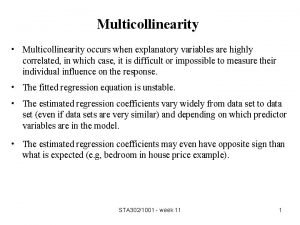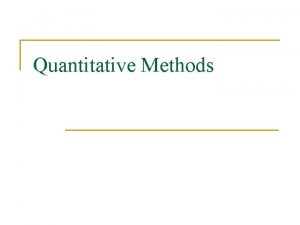Confounding and multicollinearity Confounding occurs 10000 times more



- Slides: 3

Confounding and multicollinearity • Confounding occurs 10000 times more frequently than multicollinearity • Confounder: An independent variable that changes the effect (the B’s) of other independent variables, when it’s included in the model • A confounder is differently distributed for different values of the variable it confounds • Multicollinearity is when two independent variables measure (almost) the same thing • Of course, both problems means that the indepedent variables are correlated

Collinearity • Example: Want to find the effect of weight on height • For some reason, you have two independent variables: Weight and weight+1 • Both are obviously related to height • If both are included in the model – Impossible to tell which one explains the difference in height in the data!! – Impossible to get precise B-estimates for any of them, S-E. ’s would be huge!! • Of course, real data will involve much less obvious collinearity than this example, but the same thing will happen

Trial exam exercise: • Gender and treatment cannot be collinearily related, because only the effect of gender changes from the univariate to the multivariate analysis • Also, gender and treatment measure two intuitively different things, it is arbitrary which treatment you give to each individual • If we had made sure that an eual number of males and females got each treatment, the confounding would disappear!! (I. e. gender would not have been significant in the univariate analysis either) • Whereas, if you had collinearity, you could not ”design away” the problem (because the two variables measure almost the same thing!)




